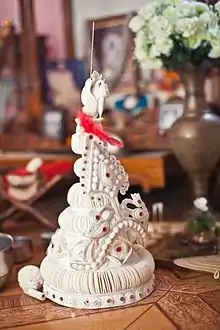Bengali Hindu wedding
Bengali Hindu wedding refers to Bengali wedding with Hindu rites and rituals native to the Indian subcontinent.[1]
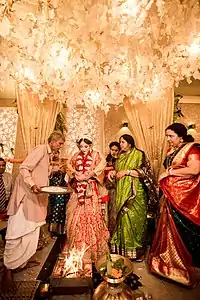
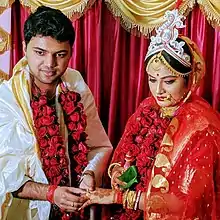
| Part of a series on the |
| Culture of Bengal |
|---|
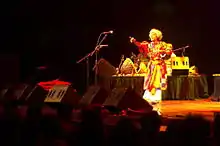 |
| History |
| Cuisine |
|
|
Arranging the wedding
A traditional wedding is arranged by Ghotoks (matchmakers), who are generally friends or relatives of the couple. The matchmakers facilitate the introduction among the family and the prospective bride and groom.
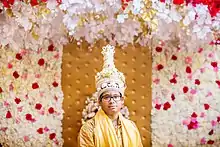
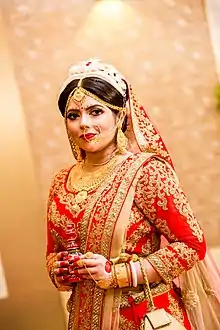
Bengali weddings are traditionally in four parts: the bride's Gaye Holud, the groom's Gaye Holud, the Beeye and the Bou Bhaat. These often take place on separate days. The first event in a wedding is an informal one: the groom presents the bride with a ring marking the "engagement", a system which is gaining popularity. This can sometimes be considered as Ashirwaad.
There can be subtle differences in Bengali Hindu marriages in West Bengal and Bangladesh. The rituals sometimes differ. In Paaka Katha (final talk), the parents of the bride/groom, along with one or two very close relatives/friends go to the other party's house to formally settle the marriage. It may be followed by a lunch / dinner.
A Bengali Hindu Marriage can be divided into the following parts:
- Pre-wedding rituals: Adan Pradan, Patri Patra, Ashirvad, Aai Budo Bhaat, Ananda nadu, Vridhi, Dodhi Mangal, Holud Kota, Adhibas Tatva, Kubi Patta, Snan, Sankha Porano
- Wedding rituals: Bor Boron, Potto Bastra, Saat Paak, Mala Badal, Subho Drishti, Sampradan, Yagna, Saat Pak (couple), Anjali, Sindur Daan and Ghomta
- Post-wedding rituals: Bashar Ghar, Bashi Biye, Bidaye, Bou Boron, Kaal Ratri, Bou Bhaat, Phool Sajja, Dwiragaman
Pre-wedding rituals
Ashirbaad – On an auspicious day the elders of the groom's side go to bless the bride and vice versa, by sprinkling husked rice and trefoil on their heads and giving them gold ornaments. It is a kind of acceptance of the boy and the girl on both sides.
Gaye Holud – A ceremony in which five or seven married women of the household grind turmeric with mortar and pestle and anoint the bride with turmeric paste, first it is been applied on groom then the same paste will sent to bride's home for applying it on her along with a new saree and gamchha (bengalee cotton towel) and other treassaud set from the boy's party. This brightens up the bride's complexion and makes her skin glow.
Dodhi Mongol – At dawn on the day of marriage seven married ladies adorn the bride's hands with the traditional bangles Shakha and Paula – one pair of red and one pair of white conch-shell bangles, and feed her a meal of curd and rice, nowadays other dishes as well, the only meal after which the bride and her parents fast the whole day. This ritual is celebrated on groom's side also.
Main wedding rituals
Bor Jatri – The members of the groom's house as well as his friends dress in their best attire and journey to the bride's house where the wedding takes place.
Bor Boron – When the bor jatri reaches the bride's place, usually the mother of the bride along with other members come out to welcome the groom and his family by showing the holy earthen lamp, sprinkling trefoil, and husked rice placed on a bamboo winnow (kula). Then they are served sweets and drinks.
Potto Bastra – After the groom is seated at the chadnatolla (wedding altar and canopy) – the sanctum sanctorum where only the groom, bride and the priest takes their place, the groom is offered new clothes by the person who is to do the sampradaan – the elderly male member of the family who does sampradaan offers the responsibility of the bride to the groom.
Saat Paak – The bride, usually seated on a low wooden stool called pidi is lifted by her brothers and is taken round the groom in seven complete circles. The significance is they are winded up securely to each other.
Subho Dristi – After saat paak the bride and the groom are made to look at each other in front of all the assembled invitees. The bride is told to remove the paan leaves. This exchange of loving glance is to initiate them to be together officially by the society.
Mala Badal – After the circles are completed, still sitting high on the piri, the bride and the groom exchange garlands of fragrant flowers thrice. This is the first step in which they accept each other.
Sampradan – The bride then takes her place at the chadnatolla where an elderly male member of the bride's family hands her over to the groom and the couple's hands are bound by the sacred thread amidst recital of Vedic chants and are placed on the mangal ghot – a brass pitcher filled with water that is covered with mango leaves attached to one twig and a green coconut placed on it.
Yagna – The bride and groom sit in front of the sacred fire and chant mantras after the priest. Agni, the fire god is made the divine witness to the marriage. See Vedic marriage.
Saptapadi – The saptapadi in Bengali wedding is quite different from what is popular ("phere") in many other parts of India. There are seven betel leaves laid out in a sequence. The bride steps on these leaves one by one followed by the groom. The groom moves a special stone "nora" (typically used for crushing and pasting spices) with his foot as they move forward.[2]
Anjali – An offering to the fire is made. The bride's brother puts puffed rice (khoi) in the hands of the bride, and the groom standing close to her holds her hands from the back and extends their arms forward. They then pour the offering into the fire together.
Sindoor Daan and Ghomta – Once again seated at their respective places in chadnatolla the groom applies sindoor or vermilion (a symbol of marriage worn by Hindu women thereafter) on the bride's hair-parting. During the process of sindoor daan the bride's head is covered with a new saree given by the groom's family. This is known as "lojja bostro".
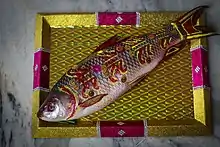
Post-wedding rituals
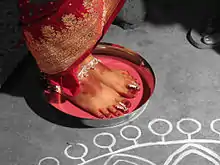
Bidaay – This is a farewell – mixed moment of joy and sorrow as the bride is bid adieu with blessings of her parents and relatives to start a new life with her beau. The bride has to throw rice in the sari of her mother to fill the responsibility of her mother to her (as it is considered that the bride is the Groom's responsibility).
Bodhu Boron - This is done when the bride reaches the groom's house. One dish is made full with alta and milk. The bride stands on it, then enters the room with groom after being welcomed by the mother-in-law.
Kaal Ratri – After the couple reaches the groom's house and the initial welcome ceremony is over they are separated for the night, probably to get a refreshing sleep and prepare for the next day's final wedding ceremony.
Bou Bhaat – The bride cooks and serves all the members of her husband's family. The husband has to gift a sari to new bride and has to take a vow of taking the responsibility of the bride's basic needs ("Bhaat Kapor" - literally meaning food & dress). A banquet is held to treat the guests who lavish gifts on the new bride.
Phool Shojja – The couple and their bed are adorned with flowers and are left together in their room to enjoy conjugal bliss. There are friends who actually stay under the bed or by the corner of the door, the groom needs to check for these devils before he begins to talk to the bride.
Arranging a wedding
Arranging a wedding is a relatively complex affair with many moving parts. Even a simple wedding requires 5–8 vendors and 300–500 guests. To simplify the process, there are event management companies that help in executing the process. Selection of food menu for the dinner party on the occasion of Bengali wedding ceremony is very critical aspect of successfully arranging a wedding.[3]
Gallery
 Bangli Hindu Wedding Rituals Sindoor Daan
Bangli Hindu Wedding Rituals Sindoor Daan Bengali Hindu Wedding Rituals Sindoor Daan
Bengali Hindu Wedding Rituals Sindoor Daan Bangli Hindu Wedding Rituals
Bangli Hindu Wedding Rituals Bengali Hindu Wedding Aashirvad
Bengali Hindu Wedding Aashirvad Bengali Hindu Wedding Gaye Holud and Snan
Bengali Hindu Wedding Gaye Holud and Snan Bengali Hindu Wedding Rituals Tattva.jpg
Bengali Hindu Wedding Rituals Tattva.jpg Bengali Hindu Wedding Sindoor Daan and Ghomta Culture
Bengali Hindu Wedding Sindoor Daan and Ghomta Culture Bengali Hindu Wedding Sindoor Daan and Ghomta
Bengali Hindu Wedding Sindoor Daan and Ghomta
See also
References
- "Bengali Wedding Rituals – A Traditional Bengali Marriage Ceremony". hinduism.about.com. Retrieved 21 November 2008.
- "Saptapadi in Bengali wedding".
- "Food ideas for the dinner party on the occasion of Bengali marriage ceremony". FavCounter. 22 September 2016. Retrieved 12 July 2019.
